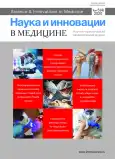Efficiency of prognostic scales in assessing patients' condition in severe acute pancreatitis
- Authors: Makarov I.V.1, Mustafaev I.A.2, Kurashev A.V.2, Budorina L.A.1, Gerasimov L.V.1
-
Affiliations:
- Samara State Medical University
- Clinical hospital RZD Medicine
- Issue: Vol 5, No 4 (2020)
- Pages: 278-282
- Section: Surgery
- URL: https://journal-vniispk.ru/2500-1388/article/view/53108
- DOI: https://doi.org/10.35693/2500-1388-2020-5-4-278-282
- ID: 53108
Cite item
Full Text
Abstract
Objectives – to compare the predictive efficiency of modern scales used in prognosis of disease severity (APACHE II, SAPS, SOFA, MODS) in patients with severe acute pancreatitis.
Material and methods. 17 patients formed two study groups: Group 1 consisted of 10 survived patients, Group 2 included 7 patients with a fatal outcome. The mortality ratio and the severity of the condition were calculated for all 17 patients, using the scales presented above, at the admission to the ICU and at the moment of transfer to a surgical department. The intensive care procedure and surgical interventions were in line with the clinical recommendations for surgical treatment of severe acute pancreatitis.
Results. The day of ICU admission, Group 1, the average mortality rate on the SAPS scale was 11±0.08%; on the SOFA scale – 27±0.08%; on the MODS scale – 1–2%; on the APACHE II scale – 8.45±0.09%. The day of ICU admission, Group 2, the average mortality rate on the SAPS scale was 5.7±7.11%; on the SOFA scale – 25.14±6.09%; on the MODS scale – 2.4±1.05%; on the APACHE II scale – 12.1±8.49%. The day of patients' transfer from the ICU to the surgical department, Group1, the average mortality rate on the SAPS scale was 8.99±0.10%; on the SOFA scale – 30±0.15%; on the MODS scale – 1–2%; on the APACHE II scale – 14.29±0.08%. The day of patients' transfer from the ICU to the surgical department, Group 2, the average mortality rate on the SAPS scale was 7.7±8.69%; on the SOFA scale – 22±0%; on the MODS scale – 1–2%, on the APACHE II scale – 12.37±9.89%.
According to our data, none of the used prognostic scales could present the real condition of a patient or the mortality prognosis for patients in both groups. By comparison of the average mortality rate calculated for patients of Group 1 and Group 2, we revealed the more unfavorable prognosis for the survived patients than for the patients with lethal outcome.
Conclusion. The objective evaluation of the severity of patient's condition and the prognosis for treatment is not possible with the scales used in the study. Among them, the SAPS and APACHE II scales provided the most precise prognoses for patients' condition.
Full Text
##article.viewOnOriginalSite##About the authors
I. V. Makarov
Samara State Medical University
Author for correspondence.
Email: makarov-samgmu@yandex.ru
ORCID iD: 0000-0002-1068-3330
PhD, Professor, Head of the Department of surgical
diseases No.1
I. A. Mustafaev
Clinical hospital RZD Medicine
Email: makarov-samgmu@yandex.ru
Head of the Department of Resuscitation and intensive therapy, anesthesiologist-reanimatologist
Russian Federation, SamaraA. V. Kurashev
Clinical hospital RZD Medicine
Email: makarov-samgmu@yandex.ru
anesthesiologist-reanimatologist
Russian Federation, SamaraL. A. Budorina
Samara State Medical University
Email: makarov-samgmu@yandex.ru
general practitioner, resident doctor of the Department of surgical diseases No.1
Russian Federation, SamaraL. V. Gerasimov
Samara State Medical University
Email: makarov-samgmu@yandex.ru
ORCID iD: 0000-0003-3869-6931
the 6th year medical student
Russian Federation, SamaraSupplementary files







